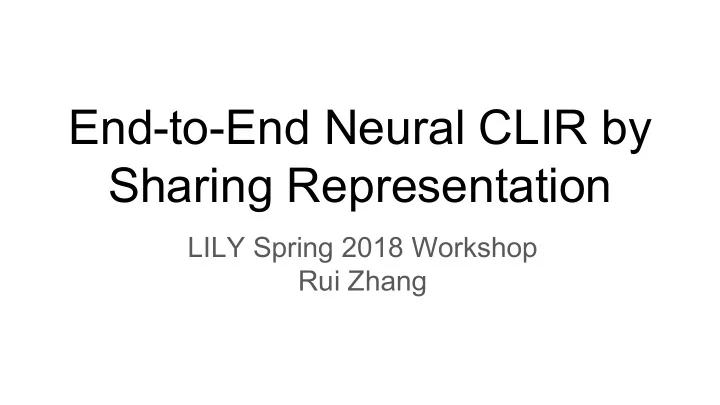

End-to-End Neural CLIR by Sharing Representation LILY Spring 2018 Workshop Rui Zhang
Cross-lingual Information Retrieval (CLIR) Information Retrieval ● Retrieve relevant documents from a corpus for a given user query. ● e.g., Google Search ● Usually monolingual, i.e., documents and queries are in the same language. ● TF-IDF, BM25 Cross-lingual Information Retrieval (CLIR) ● The documents are in a language different from that of the user’s query. ● e.g., an investor wish to monitor the consumer sentiment from tweets around the world.
Methods for CLIR Translation-based approach ● A pipeline of two components: translation + monolingual IR ● Can be further divided into document translation and query translation e.g., the query is in English and documents are in Swahili ● Query translation from English to Swahili using a bilingual dictionary. ● Document translation from Swahili to English using a machine translation system.
Methods for CLIR Translation-based approach is difficult ● Query Translation ○ rely on a comprehensive bilingual dictionary ○ Hard to translate short text queries and phrases ● Document Translation ○ Need to build a reliable machine translation system ● Especially for low-resource languages
Neural (Monolingual) Information Retrieval Many successful neural IR systems have emerged: ● DUET (Mitra et al., 2017) ● PACRR (Hui et al., 2017) ● DSSM (Huang et al., 2013) ● DESM (Mitra et al., 2016) ● MatchPyramid (Pang et al., 2016) ● DRMM (Guo et al., 2016) … ... But, they are evaluated in Monolingual IR settings.
Research Goal and Challenges Goal: Build an end-to-end neural CLIR that ● models local information ○ unigram term match ○ position-dependent information such as proximity and term positions. ● models global information ○ semantic matching in distributed representation space ● directly learns from (query,document,relevance) supervisions ● performs better than the pipeline translation-based approach because it avoids cascading errors
Research Goal and Challenges Challenges ● How can we capture local information and global information when query language and document language are different? ● How can we use and learn shared representation for multiple languages?
Proposed Method 1) Use multilingual word embeddings to build a similarity matrix. ● This models local information. MatchPyramid (Pang et al., 2016)
Multilingual Word Embedding https://github.com/facebookresearch/MUSE
Proposed Method 2) Use monolingual or multilingual embedding to learn a shared distributed representation ● This models global information.
DUET for CLIR - Local Model
DUET for CLIR - Global Model
Data Sets WikiCLIR (Sasaki et al., 2018) ● Automatically created from parallel wiki pages ● Large-scale, 25 languages Standard CLIR task ● CLEF ● NTCIR ● TREC
Recommend
More recommend